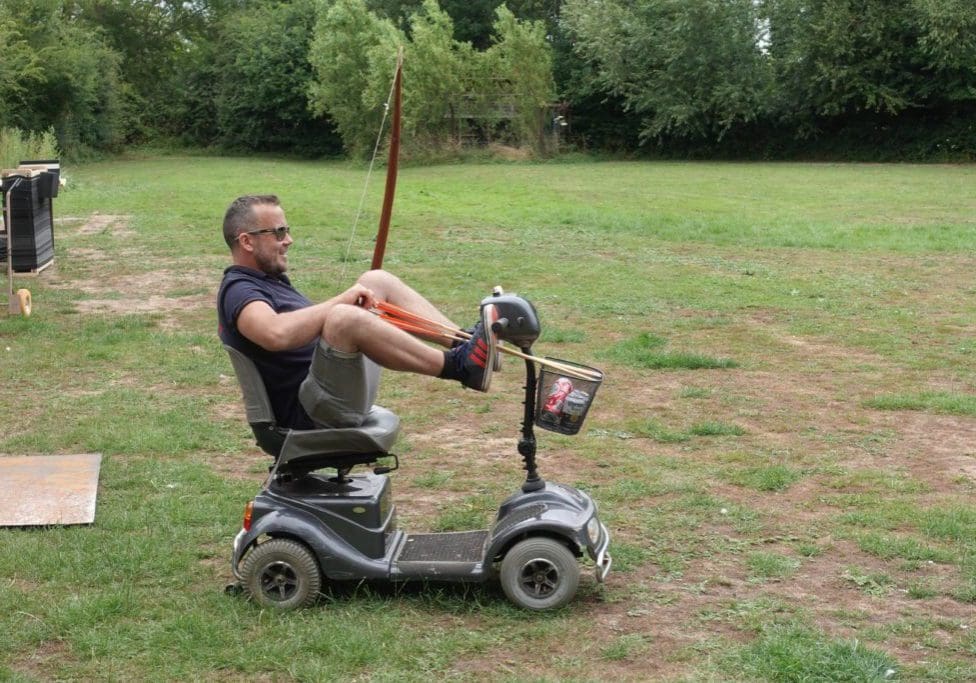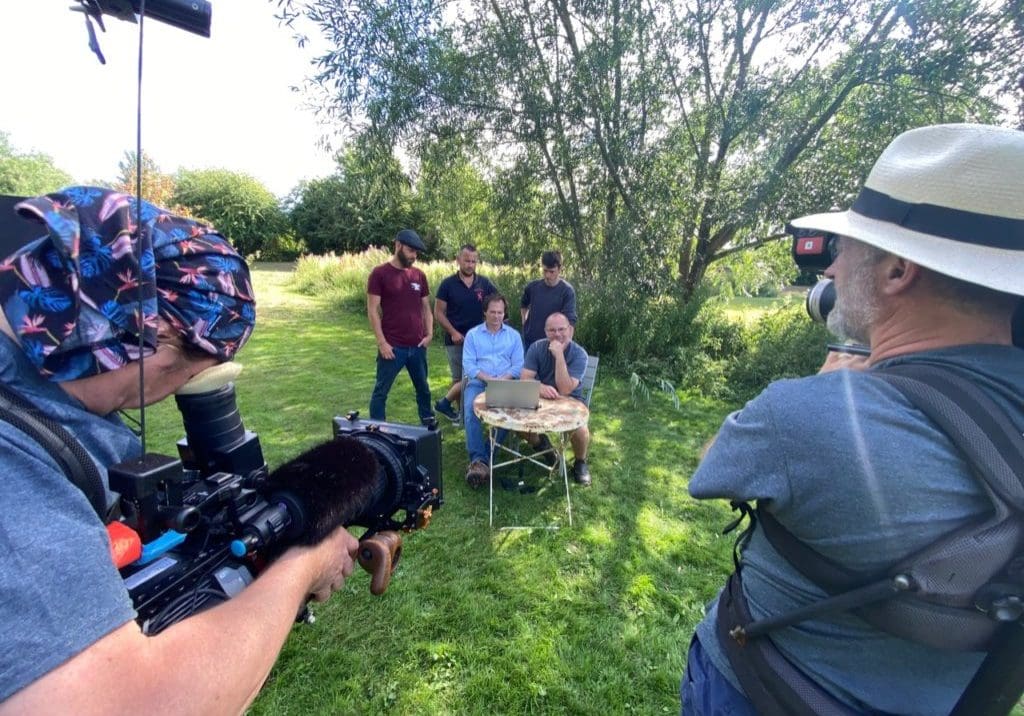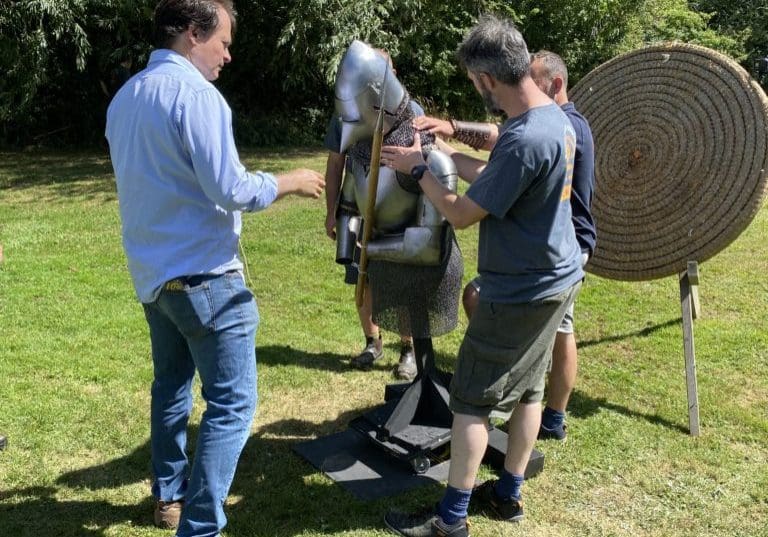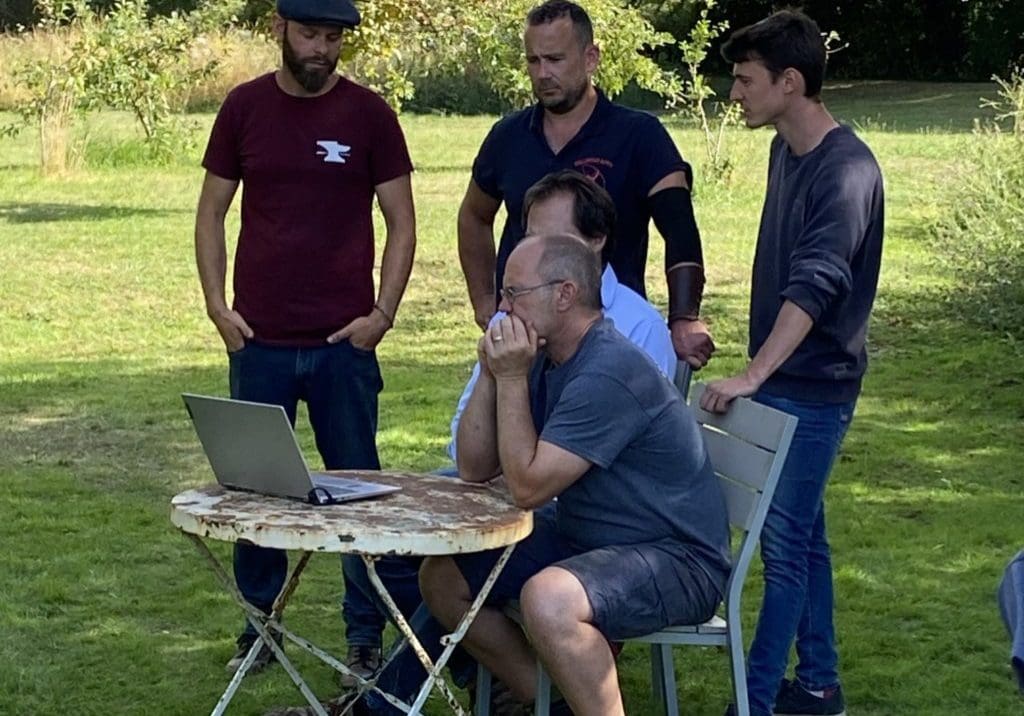Four Films
Four Films
Medieval Myth Busting
Introduction
Arrows v’s armour was a great success and the reception to it was amazingly good. I suspect because we were open and forward with our information and didn’t exaggerate or add an agenda, in addition to having authentic kit. Lets keep going in that line.
Firstly I apologise for not getting this moving forward earlier, as we want to keep the momentum up, but conversely the slowness of getting the next going has allowed me to chat over aspects with most of you and develop the ideas up, so it has been better for that delay.
The next principle film will be shooting at a helmet and aventail and this will take time to get together, so my original thought was to make a small, but related and important film first and get this out there to keep interest going while we prepare and shoot the helmet film. However……
The small film it turns out will not be that small and there have been a couple of additional spin off films that I think we should do as well and before the helmet. Probably best to explain in short terms what and why and then expand.
The reason I have laid out the films like this is to provide as good a foundation as possible for the next milestone of our journey and that is the helmet; so I view these as necessary to inform ourselves and others of what we will be seeing. Clearly they will take considerable funding, and it seems like a little cheat to use the helmet funds for this, but I am pretty sure I alluded to this in the funding film we shot at the Wallace and I think they are important enough to excuse them.
Film outlines
Film 1 – Bodkins
Try and find an optimum bodkin shape using existing examples as models and try and ascertain if ‘steeling’ makes a difference
Reason – to find our head form or justify the one we have used so this becomes our standard for future films.
I believe that wax would have been used as it clearly improves performance against fabric massively, but does it improve against steel? Run the tests ‘dry’ then run our winner with and without wax.
Film 2 – Arrows against maille
Not pretending to represent maille as worn
Reason – to discover whether Indian maille is easier to penetrate than 100% authentic maille and to what extent it is weaker. Principally because it is likely to be prohibitively expensive and time consuming to commission an authentic aventail, and eventually whole shirt, so we need to think about using Indian maille but need a data point.
Place two samples of maille onto a doublet and then onto ballistic gel and shoot them and observe the depth of penetration.
The first sample will be Indian maille and the second will be authentic maille.
Genuinely short.
Film 3 – flat plate shooting
Material comparison test – so not pretending to represent armour as worn
Reason – to discover how thick a plate, of what material, an arrow can shoot through and still do damage on the other side. I find it hard to pin down exactly what we will get out of this test, but it will enlighten our discussions and generally just be damn interesting.
Shooting at curves is not repeatable, so the only way to compare ‘like for like’ is to shoot onto a flat plate and shoot at a variety of materials. In the future, we will strive to use period materials where possible but the testing of analogues alongside period materials will enlighten everybody’s work as well as ours, but also it will allow us to stand on proper knowledge in the future if we have to use non-authentic materials.
The finale of this film will be to compare 2.5mm 1050 with 2.5mm of our authentic steel.
Film 4 – shooting a helmet and aventail
Reason – to discover if a helmet can be penetrated and how effective the helmet design is, but also how effective the aventail is as a primary defence, and whether skating shots coming up off the breast plate compromise the armour.
The existing breastplate and the new helmet and aventail will be fitted onto a gel torso and head and mounted in similar way to before. Attention will be paid to trying to capture the arrow heads. There are several required sequences to film.
Full front onto the helmet
Side onto the helmet
Breaths and/or sights plumb on
Aventail plumb on
Breast above the V under the aventail
Optional but interesting – side of the breast
The four films in more detail
Film 1 – Bodkins….
We chose a likely candidate with provenance, but we can’t say it was optimal from all the original examples for our purposes. We need to look at this and that is best done at the start of our journey.
Lets look at the steeled possibilities, tip form and weights.
We have to address weight and the 1/4lbs arrow. Joe and Will believe they shoot like pigs and the only evidence is an entry saying “people don’t shoot them anymore’. We can discuss how to address this but basically say, yes they penetrate better, but you lose other aspects and there is no evidence they did use them, so lets stick with what we know they did do. (or something like that).
Owen Bush thinks penetration has as much to do with tip form as with material, so can we look at three extant examples from the pointy to the blunted in the short bodkin classification.
We also need to nail the ‘steeled’ references, so we should compare wrought, steel and case hardened wrought. For our tests throughout the series we are likely to continue to use wrought heads, because we know they used them, but we must look at steeled heads. These may have been case hardened, or fully steel.
Observe the difference in the three head types against a homogenous material, allowing comparison of like for like, so I suggest 1.5 or 1.8mm mild steel on a homogenous backing (PU foam) with no maille and no doublet. This allows us to look at the head material and form and how this effects performance, in isolation to any other factor.
Special guest would be Hector Cole.
Film 2 – shooting at Maille
I have had a couple of long chats with Nick Checksfield that were every useful. He is interested in being involved, but the price and time scales for a proper aventail are difficult. This leaves us no choice but to set a data point for the resistance of maille using a smaller and simpler piece of authentic maille alongside a piece of carefully selected and partially reworked Indian maille. It is possible for Nick to look at each rivet and cut out and replace dodgy links.
The aim of the film is to discover the difference in durability of Indian maille against authentic maille allowing us to carry on our tests using Indian maille, but with the knowledge of the difference between the two.
Nick also said he has pictures of maille being case hardened, so this is something we could either discuss or do.
The test will have a gel block on a mobile stand, fronted with a jack sample and then the maille at a close distance. We cannot get a number for this difference in this way, we can merely observe that the “shot against the Indian maille allows the arrow to pass 2″ deeper into the gel” or whatever. We could get a proper number if we took our sample to materials testing lab, but I am loathe to do this as I think it strays from our “real world” actions and it starts us on a truly scientific research project and I for one am not putting a Phd together. It could be worth it, but even if we find out it is 15% weaker, we cannot say as a fact whilst looking at an arrow strike later “with the 15% increase in strength of authentic maille it would have turned our arrow”. So basically I don’t think it really gets us anywhere in the context of what we are doing here.
Special guest star would be Nick Checksfield.
Film 3 – Flat plate shooting
It is not possible using armour to compare different shots and so to set a series of data points for different materials this must be done in a repeatable way. The only way to make it repeatable is to shoot at flat plates with a homogenous backing. To aid us, this can be done at a short range – 10m.
Great care must be taken with the wording at the introduction to explain why we are doing this, so nobody can think we are pretending it is representative of armour. We must also pass a nod to the defence research tests that were done a while back and although our take is a bit different, we should familiarise ourselves with them and highlight when our results are similar or different.
We have several aims for this film Compare original type materials; one against the other
Compare analogue materials to see how they perform against the originals
Compare authentic steel against 1050 at 2.5mm thick
Discover what thickness of plate can be defeated and for the arrow to continue through the secondary armour. i.e. what thickness would stop a deep wound. We will look at
Mild steel
1050 steel
poor wrought
Good wrought
Authentic steel
It would be great to test all these materials in different thicknesses, but there are simply too many variables, so we need to settle on a thickness that we believe will be defeatable and one that is not likely to be defeated. We take the same shot 3 times at the thinner plates and then 3 times at the thicker plates.
In all cases the flat plate will be immediately backed by a sheet of maille, an arming jack and then gel.
We are shooting into the plate backed by the under layers so we can see whether a shot that penetrates the armour would also go through the secondary armour. Sequence 1
Shooting at 1.5mm (example) plates of assorted materials, all backed by the underlayers Sequence 2
hooting at 2.0mm (example) plates of assorted materials, all backed by the underlayers
Material sourcing and processing
Mild and 1050 – no problem
Wrought comes in different qualities. It was all ostensibly the same stuff, but once it is worked it becomes clear if it stays together or tears easily; due to levels of impurity and other processing factors. I have handily called this poor and good. This difference would have been known to the smiths of the day as you cannot miss it whilst working it, so we have to assume that they graded their armour materials according to the quality of the iron they used. So lets test the two ends.
Authentic steel. We can convert some wrought into steel and only once it is made can we test for carbon content, so this will be a bit hit or miss on exact specs.
Both wrought and steel are available through Owen Bush, who has a big name, but also a big price. My friend and Bush protégé James Woods can process this for us and will be much cheaper and if the end result is the same…..The material will be hammer beaten, not rolled so it will be a nominal thickness and some areas will be +- 0.2mm (estimate). – as theirs would have been. In itself this complicates testing and hence looking at analogues, because a strike on 1.5mm mild will strike a material thickness of 1.5mm, on a sheet of wrought it might be 1.3mm or 1.7mm.
Maille is again an issue. I was speaking to Nick Checksfield at the weekend who is keen to be involved, but the last time he quoted an aventail, he quoted keen at £7,000 and not in a hurry. We had a good and wide ranging chat and in essence his mail is made from mild as is the Indian stuff, though the way they are riveted is different, which effects the strength of the Indian, as does the lack of care in production. He believes he can check an Indian piece and replace the dodgy links and retailor it properly for our application and we will end up with a piece that is good but weaker than fully authentic. I think at these prices and the time frames involved, we have no real choice but to test an Indian piece as an analogue alongside a proper piece and set a data point. We will of course be open and frank about this.
Film 2 will set this required benchmark for the maille and give us at the least, considered foundations to stand on whilst using it to back up our plate tests.
Special guest star would be Alan Williams
Film 4 – Helmet and aventail
The three previous films we try and keep it as small as we can, but make a nice job of it; this one will be more like arrows v’s armour and we will go all out where we need to.
This will include one or two professional camera operators and a sound recordist for the field day.
We meet up at the Wallace and look at the helmet – some or all of us and that becomes the opener and allows us to justify why we are looking at that helmet.
Kevin makes a replica of the helmet from authentic steel if we can source it (should be possible).
Nick modifies and checks an Indian aventail and fits it to the helmet.
Helmet and aventail comes to the field and we set it up on a gel torso with the breastplate and shoot it with a single arrow type from different directions at a set distance 25m? We make efforts to save the heads for examination.
Joe shoots from different directions and we see what happens. As part of this it would be good to land one above the V, another direct into the aventail and another onto the side of the breastplate.
Whatever happens it will be interesting and our discussions should simply be a result of what we see, whether it is deflections, shrapnel or full on penetration.
Stunning shots will be provided by a camera inside the helmet peeking out through the eye slits.
Conclusion
If we didn’t make a landmark before, we will have done after this lot, but it will of course be expensive, so once the basic outline is agreed, I will finish off the funding estimate and we will start kick starter off.
In the unlikely event we raise more than we need, we will find a good use for it I am sure. In the more likely event we don’t raise enough, then we will have to think again.
Four films – short version
Yes four films. The reason is to provide as good a foundation as possible for the next milestone of our journey and that is the helmet; these will need to be funded. We will try to get ‘special guest stars’ in and try to be as authentic as possible with materials.
This document is the short version; there is an 8 page version available which expands on reasoning and methods, if you feel the need………
Bodkins
Try and find an optimum bodkin shape using existing examples as models and try and ascertain if ‘steeling’ makes a difference.
Reason – to find our head form or justify the one we have used, so this becomes our standard for future films.
Method – Flat sheets of mild and check depth of penetration into back stop.
Guest – Hector Cole
Arrows against maille
Not pretending to represent maille as worn.
Reason – to discover whether Indian maille is easier to penetrate than 100% authentic maille and to what extent it is weaker. Principally because it is likely to be prohibitively expensive and time consuming to commission an authentic aventail, and eventually whole shirt, so we need to think about using Indian maille but need a data point.
Method – Place sample of authentic and Indian maille onto a doublet and then onto ballistic gel and shoot them and observe the depth of penetration.
Guest – Nick Checksfield
Film 3 – flat plate shooting
Material comparison test – so not pretending to represent armour as worn
Reason – to discover how thick a plate, of what material, an arrow can shoot through and still do damage on the other side. Just generally interesting.
Method – Shoot onto a variety of flat plates. In the future, we will strive to use period materials where possible but the testing of analogues alongside period materials will enlighten everybody’s work as well as ours, but also it will allow us to stand on proper knowledge in the future if we have to use non-authentic materials.
The finale of this film will be to compare 2.5mm 1050 with 2.5mm of our authentic steel.
Guest – Alan Williams
Film 4 – shooting a helmet and aventail
Reason – to discover if a helmet can be penetrated and how effective the helmet design is, whether it can be penetrated, but also how effective the aventail is as a primary defence, and whether skating shots coming up off the breast plate compromise the armour. Will strive to source authentic material.
Method – The existing breastplate and the new helmet and aventail will be fitted onto a gel torso and head and mounted in similar way to before. Attention will be paid to trying to capture the arrow heads.
Schedule
Planning to start filming again in March or April, for the first two, 3 and 4 will be a bit later.
First 3 films will be smaller in terms of cameras etc, last film will have the extra cameras etc as before.




